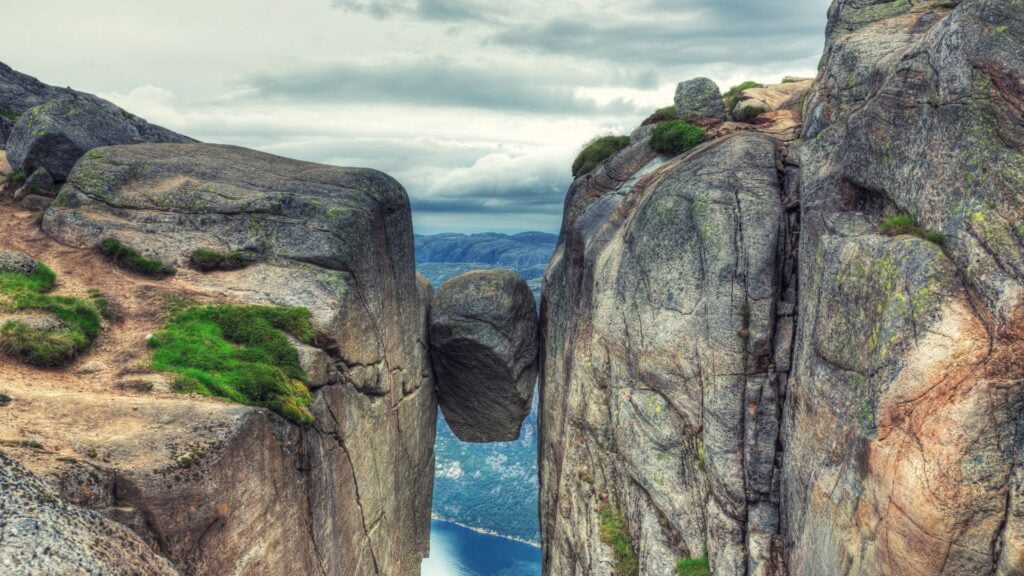Oh Flørli, that place where you can find the world’s longest wooden staircase. Located in the scenic Lysefjord, in Norway, the staircase boasts 4,444 steps and climbs an impressive 740 m (2427 ft) vertically up the mountainside. Are you in the mood for a more unusual trekking experience? If so, here’s your guide to hiking Flørli 4444.
Why Flørli is an unusual European destination
Flørli is a rather charming and remote village that has a unique attraction: the world’s longest wooden staircase. Known as Flørli 4444, this staircase has 4,444 steps (hence the name) and was originally constructed in the early 20th century to service a hydroelectric pipeline. The staircase now operates as a peculiar hiking trail that is also pretty – you’ll be treated to panoramic views of the fjord, dense forests, and the cascading waters of mountain streams.
Old Florli Power Station at Lysefjord Forsand
As you might suspect, not that many people have heard of Flørli 4444 and few can say they have climbed it. Only a few thousand people climb the stairs each year, while around 20,000,000 visit London or Paris. Given the quirkiness of the hike and the relatively low number of tourists who reach the last step, it’s reasonable to say that Flørli is one of those unusual European destinations.
A few facts about Flørli and Lysefjord
Lysefjord is a well-known fjord located in southwestern Norway. This 40-km/25-mi-long fjord, formed by tectonic movements and glacial activity, plunges to depths of over 400 m (1,312 ft) in some places, creating quite a spectacle.
The most famous landmarks in Lysefjord are the Preikestolen (also known as Pulpit Rock) and Kjerag. Preikestolen is a flat-topped cliff rising 604 m (1981 ft) above the fjord. The formation of this cliff dates back to the last ice age, around 10,000 years ago, when glacial movements and subsequent erosion shaped the landscape. The hike to Preikestolen is moderately challenging and takes about 2-4 hours round trip.
Preikestolen or Pulpit Rock can get pretty crowded
Kjerag is another famous destination, known for the Kjeragbolten boulder wedged between two cliffs. This hike also has origins in the glacial activity that shaped the region, with the unique boulder placement resulting from glacial wedging during the last ice age. Kjerag is more demanding, but the experience of standing on the boulder and the spectacular views of the fjord are arguably well worth the effort.
The famous Kjeragbolten boulder
The vegetation in the Lysefjord area is characterized by lush forests and a variety of plant species that thrive in the cool, moist climate of western Norway. The area around Flørli is predominantly covered with mixed forests, including birch, pine, and spruce trees. These forests provide a dense, green canopy that shelters a variety of undergrowth.
During the spring and summer months, the trails are adorned with colorful wildflowers. Species such as heather, wild orchids, and various ferns add vibrant splashes of color to the landscape. In late summer, the region’s forests and meadows are dotted with berry bushes. If you hike in the region during this time, you will likely find blueberries, lingonberries, and cloudberries.
Cloudberry bush
Animals you might encounter in the forests around Flørli include deer and foxes. While they are both usually shy, they can occasionally be seen, especially during the quieter parts of the day. Seals are also a common sight, and you might even spot porpoises swimming in the fjord. And if you look up, you may see eagles, hawks, and a variety of songbirds. The fjord attracts seabirds like gulls and cormorants.
What does the fox say?
A seal relaxing in the water
This is a porpoise, a type of small dolphins
Sea gulls
Things to expect when hiking Flørli 4444
The total round-trip hike covers approximately 5 km (3.1 mi). The climb up the staircase itself is 1,470 m (0.9 mi) long with an ascent of 740 m (2,427 ft). The entire hike, including the descent, typically takes about 3 to 4 hours to complete.
The hike begins at the Flørli quay. From here, you’ll follow signs to the base of the staircase, which runs alongside the old hydroelectric pipeline. Climbing the 4,444 steps is a rather rigorous workout. Fortunately for you, stairs are interspersed with rest points, benches, and lookout spots where you can catch your breath and enjoy the views of Lysefjord. And if you’re at least a bit nerdy, you will be glad to know that historical markers along the way provide insights into the hydroelectric plant’s history and the construction of the stairs.
As you ascend, you’ll be treated to pretty views of the fjord, the surrounding mountains, and the dense forests. The higher you climb, the more expansive the vistas become. The staircase ends near Lake Ternevatnet. Many hikers take a refreshing dip in the summer months.
Aerial view of Lysefjord
The recommended descent route is the Rallarstien path. This historical trail, used by workers who built the original pipeline, winds through lush forests, rocky sections, and open meadows. The Rallarstien path leads you back to the village of Flørli, where you can relax at the local café, visit the power plant museum, or do some kayaking.
How to get to Flørli 4444
The closest airport to Flørli is Stavanger Airport, which serves both domestic and international flights. From the airport, you can travel to Stavanger city center, which is the starting point for your ferry journey to Flørli.
Stavanger seems to be quite pretty
Since Flørli is a roadless village, the most common and scenic way to reach it is by ferry. Here are some options:
- Rødne Fjord Cruise: From downtown Stavanger, head to Strandkaien, Vågen, where the Rødne Fjord Cruise ferries depart. This ferry takes you directly to Flørli through the Lysefjord, offering views of the fjord’s landscapes, including the famous Preikestolen (also known as Pulpit Rock).
- Kolumbus Ferry: This ferry service operates year-round, with multiple daily departures, except on Saturdays. The journey from Stavanger to Flørli takes approximately 1 hour and 45 minutes.
- A Fjords Sightseeing Cruise: If you are looking for a leisurely sightseeing cruise experience, you may want to choose from one of the several guided tours available. For example, one well-reviewed tour that includes an audio guide is Stavanger: Scenic Fjord Cruise to Lysefjord and Preikestolen.
- TheExpress Boat from Lauvvik: Another option is to travel to Lauvvik, a small ferry quay in the Sandnes municipality, and take the express boat to Lysebotn, which stops at Flørli. This route offers a shorter ferry ride but requires additional travel to Lauvvik.
- A private boat: For those with access to a private boat, Flørli has a guest jetty available. This option offers the most flexibility but requires boating experience and access to navigational charts of the Lysefjord.
It’s recommended to book your ferry tickets in advance, especially during the peak tourist season from June to October.
Best time to climb Flørli 4444
For most people, the best time to hike Flørli 4444 is between late spring and early autumn (May to October). During this period, the weather is generally mild, and the trails are clear of snow and ice.
Norway experiences long daylight hours in the summer, providing plenty of time to complete your hike. Conversely, daylight is limited in the winter months.
June to August is the peak tourist season, offering the best weather and the most extended daylight hours. This is also when ferry services are most frequent, and additional activities and tours are available. May and September, on the other hand, are better times to visit if you prefer fewer crowds while still enjoying relatively good weather (at least by Norwegian standards). However, ferry schedules may be less frequent.
Things to do before or after hiking Flørli 4444
Just because you’ve managed to climb Flørli 4444 doesn’t mean it’s time to go home. For instance, you can go kayaking, so that you take a better look at the fjord’s waters and get up close to its dramatic cliffs and waterfalls. One of the most popular waterfalls in the area is the Hengjanefossen Waterfall. The popularity may be due to the fact it plunges from a height and can be accessed via a scenic hike. And if you enjoy sailing around the fjord, you can also take a fjord cruise, be it a serene electric ferry ride or a high-speed RIB boat tour.
If you’re a thrill-seeker +, rock climbing on the fjord’s steep cliffs might be your thing, especially since there are routes suitable for different skill levels.
And after so much thrill, perhaps you want to go to the Eagle’s Nest (Ørneredet) viewpoint. This lesser-known spot offers a relaxing retreat with views of the fjord.
Guided tours around Flørli 4444
One option is the guided hike to Flori 4,444 steps, which provides round-trip transfers from Stavanger. While in the area, you may want to consider taking other Stavanger tours, as the place is, as you already know by now, quite picturesque and, as already mentioned, home to Preikestolen – one of Norway’s most famous hikes.
Bottom line: Embrace the Stairway to (the Norwegian) Heaven
Are you about to climb what’s probably one of the world’s most scenic leg workout? Why wouldn’t you be; after all, it’s a 4,444-step journey that will test your physical endurance and mental fortitude. Perhaps you’ll ascend higher than you ever thought possible (literally and figuratively), all while questioning your life choices with each step. But don’t worry, those panoramic views of the fjord and the bragging rights you’ll earn at the top will probably make up for the thigh-busting climb.
After you’ve conquered the stairs and made your way back down via the scenic, but still annoyingly challenging, Rallarstien path, you can reward yourself with some coffee at the local café. And once you feel well rested, consider giving a try to some of the other hotspots that make Lysefjord an entertaining hiking destination.






















